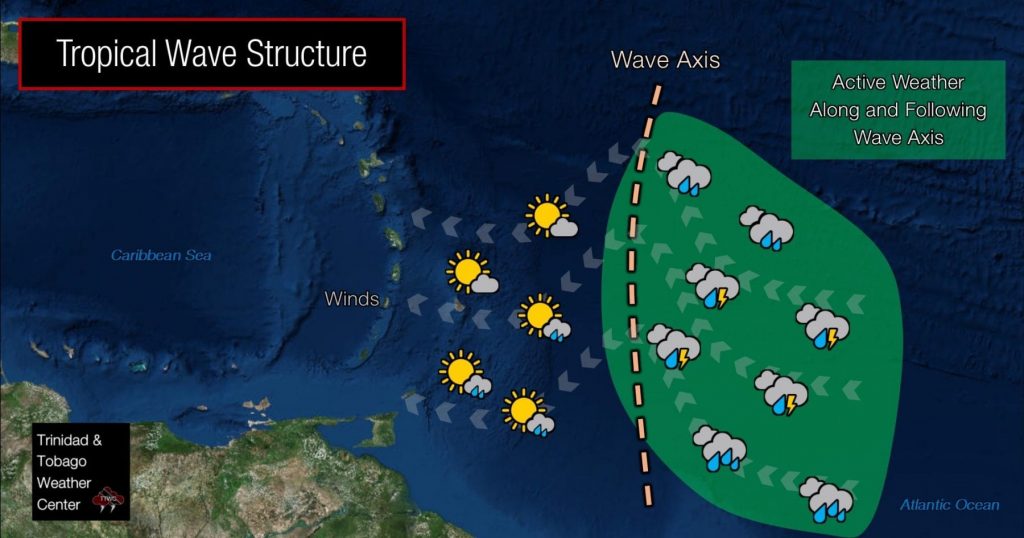Weather enthusiasts on social media were buzzing with excitement overnight as the Barbados Meteorological Service (BMS) analyzed what they consider to be the first Atlantic tropical wave of the year. However, based on analysis by the National Hurricane Center (NHC), this area of weather may just be another surface trough. Regardless, well ahead of this trough or wave, according to the Trinidad and Tobago Meteorological Service (TTMS), relatively wet weather is still forecast mainly from Thursday afternoon (isolated activity), with rainfall on both Friday and Saturday.
What you need to know
— What happened: The Barbados Meteorological Service analyzed what they consider to be the first tropical wave for 2024 in the Atlantic.
— Why does this matter: Rainfall resulting from the passage of the first tropical wave or the first modulation of the Intertropical Convergence Zone across T&T triggers the start of the local Wet Season. The Trinidad and Tobago Meteorological Service has repeatedly stated the 2024 Wet Season is set to begin earlier this year.
— What does this mean for you: You should begin preparations for the onset and duration of the 2024 Wet Season, regardless of whether this is a tropical wave or not. T&T is forecast to experience some wet weather from mid-Thursday through mid-Saturday unrelated to this area of cloudiness in the East Atlantic.
Who Decides What Is & Isn’t A Tropical Wave?

A tropical wave is a type of trough, i.e., an elongated area of relatively lower air pressure that is typically oriented north to south. Approximately 60 waves track across the Atlantic Ocean annually, and 30-40 directly impact Trinidad and Tobago. These systems, also called African easterly waves, are among the main rainfall-producing features for Trinidad and Tobago.
Tropical Waves can be significant rainfall producers in the tropics, with heavy convection (thunderstorms) usually on the east side of the wave axis and generally clear weather on the west side of the axis.
Generally, these waves are inverted troughs of low pressure, seen as an inverted v-pattern in satellite imagery. These tropical waves can have a few points of origin. However, the NHC designates these troughs of low pressure when there is a clear origin from convection in Northern Africa and the African Easterly Jet. Other local and regional organizations can sometimes apply these definitions to surface to low-level troughs generated in the East Atlantic near Western Africa or the Gulf of Guinea.
This could be the case with the BMS. Generally, we look towards the NHC’s Tropical Analysis and Forecast Branch’s Surface Pressure Analysis of the Atlantic for these features. In fact, in our annual tropical wave numbering, we use the NHC’s analysis as our baseline for counting. However, tropical waves are sometimes dropped and added to their analysis, which is done every six hours. At times, features that were analyzed as troughs initially can be reanalyzed into a tropical wave by the NHC as well.
Read More
Tropical Waves
The Case For This Tropical Wave

Several tools are used to track the genesis and progression of tropical waves. However, the main tool used is satellite imagery using specialized diagrams called Hovmöller Diagrams seen above.
We can clearly see an area of cloudiness, showers, and thunderstorms tracked westward from April 17th through April 17th, entering the Atlantic Ocean.
Though invisible to the naked eye, the energy associated with these systems can be seen using specialized satellite imagery and wind data, particularly at the 700- and 850-millibar levels of the atmosphere.

There is some very weak spin at both the 700- and 850-millibar levels, but in that vicinity, the Intertropical Convergence Zone is also present, where there is a natural area of spin in the atmosphere.
In addition, tropical waves tend to have a significant volume of atmospheric moisture. This seems to be the case with the BMS-analyzed tropical wave.

Early-season tropical waves aren’t unusual. In 2022, the first wave analyzed by the BMS occurred on April 23rd, while the first wave analyzed by the NHC came on May 8th. It’s also important to note that many of these early-season waves typically move south of Trinidad and Tobago. Last year, the first wave analyzed on April 30th moved south of T&T, and so did the subsequent two. This year, forecast models indicate this first possible wave will have the same fate.
What does this mean for T&T?

For Trinidad and Tobago, the Trinidad and Tobago Meteorological Service is the sole arbiter to determine whether a system is a tropical wave or something else and declare the beginning of the Wet Season. Given that top global models show much of the moisture associated with this feature off the African coast tracks into South America, remaining generally south of Trinidad and Tobago between April 23rd and April 24th, it is unlikely the 2024 Wet Season will be declared unless measurable rainfall occurs at Piarco and/or Crown Point.
Still, relatively high levels of atmospheric moisture will be present across T&T from Thursday through Saturday due to an induced trough across the region. Trinidad, Tobago, and the southern Windward Islands are already on track to see a relatively active 60-hour period of weather due to a trough system and localized climatic effects. On Thursday afternoon (today), a combination of an influx of moisture, daytime heating, and sea-breeze convergence is forecast to lead to pop-up afternoon showers and isolated thunderstorms favoring southern and western coastal Trinidad. By nighttime, additional showers and even the odd thunderstorm are forecast to develop offshore eastern and southeastern Trinidad. For Friday and the first half of Saturday, unsettled weather is also in the forecast.

By late Saturday, a surge of trade winds and a significant surge of Saharan Dust is forecast to move in across the region, which will limit further showers or thunderstorms across T&T, and this dust will also limit rainfall along the northern portion of the possible tropical wave/trough axis.










